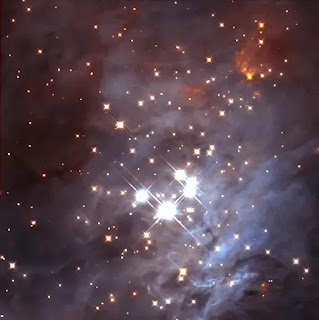ORION NEBULA:
The Orion Nebula, also known as Messier 42 or M42, is one of the most famous and well-studied nebulae in the sky. It is a vast region of star formation and offers astronomers a closer look at the processes involved in the birth of stars and planetary systems. Here is a detailed overview of the Orion Nebula:
Basic Information
- Location: Constellation Orion
- Distance: Approximately 1,344 light-years from Earth
- Size: About 24 light-years across
- Magnitude: 4.0, making it visible to the naked eye under good conditions
Structure and Composition
- Gas and Dust: The Orion Nebula is primarily composed of hydrogen gas, which makes up the bulk of its mass. It also contains helium, oxygen, nitrogen, and other elements. The nebula's vivid colors are due to the emission of light from ionized gas.
- Trapezium Cluster: At the heart of the nebula is the Trapezium Cluster, a group of young, massive stars. These stars emit intense ultraviolet radiation that ionizes the surrounding gas, causing it to glow and making the nebula visible.
- H II Region: The Orion Nebula is classified as an H II region, a type of emission nebula where the ionized hydrogen emits light.
- Proplyds: The nebula contains many protoplanetary disks, or proplyds, which are regions of dust and gas surrounding new stars. These proplyds are the potential birthplaces of future planetary systems.
Observations and Studies
- Telescopic Views: The Orion Nebula is a popular target for both amateur and professional astronomers. Through small telescopes, the nebula appears as a faint, cloudy patch with the Trapezium stars at its center. Larger telescopes reveal intricate details, including the shapes of the gas clouds and the regions of active star formation.
- Spectroscopy: By analyzing the light from the nebula using spectroscopy, astronomers can determine the chemical composition, temperature, density, and motion of the gas. This helps in understanding the physical processes occurring within the nebula.
- Infrared Observations: Infrared telescopes, like the Hubble Space Telescope and the Spitzer Space Telescope, can penetrate the dust clouds and reveal the hidden stars and protoplanetary disks. These observations have provided valuable insights into the early stages of star formation.
- Radio and X-ray Observations: Radio telescopes detect the cold molecular gas in the nebula, while X-ray observations can reveal the hot, energetic regions around the young stars.
Importance in Astronomy
- Star Formation: The Orion Nebula is a prime example of a stellar nursery, where new stars are born from the collapse of gas and dust clouds. Studying this region helps astronomers understand the processes of star formation and the initial stages of stellar evolution.
- Protoplanetary Disks: The presence of numerous protoplanetary disks in the Orion Nebula provides a unique opportunity to study the early stages of planetary system formation. This can offer insights into the origins of our own Solar System.
- Chemical Enrichment: The nebula plays a role in enriching the interstellar medium with heavier elements produced by previous generations of stars. This enrichment is crucial for the formation of new stars and planets.
- Turbulence and Dynamics: The complex interactions between the intense radiation from young stars and the surrounding gas and dust create turbulence and dynamic structures within the nebula. Studying these dynamics helps improve our understanding of the interstellar medium.
Notable Features
- The Trapezium: The central star cluster, consisting of four primary stars in a trapezoidal arrangement. These stars are some of the youngest and most massive in the nebula.
- Orion Bar: A prominent ridge of gas and dust that is being eroded by the intense radiation from the Trapezium stars.
- Herbig-Haro Objects: These are small patches of nebulosity associated with newly formed stars. They are created when jets of gas ejected by young stars collide with the surrounding gas.
Cultural and Historical Significance
- Mythology: Named after the hunter Orion from Greek mythology, the constellation and its nebula have been known since ancient times.
- Observational History: First identified as a nebula by Nicolas-Claude Fabri de Peiresc in 1610, it has been studied extensively since then. It was later included in Charles Messier's catalog of nebulae and star clusters in 1769.
The Orion Nebula remains one of the most important and visually stunning objects in the night sky, offering astronomers a wealth of information about the processes that shape our universe.




Comments
Post a Comment